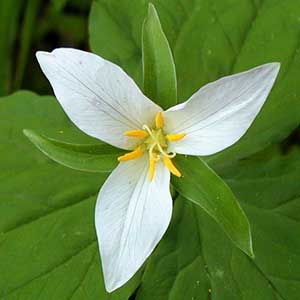Trillium ovatum
Trillium simile
Pacific trillium, trillium, western trillium, western wake-robin, western white trillium, white or western trillium, white trillium
confusing trillium, jeweled wakerobin, sweet white trillium
semierect to horizontal, short, stout, praemorse.
forming clumps, stout, praemorse.
1–2, round, 2–5 dm, ± slender, glabrous.
1–many, round in cross section, 3–6 dm, stout, glabrous.
sessile, subsessile, or short-petiolate;
blade medium green, sometimes blotched and mottled, main veins prominent, ovate-rhombic, 7–12 × 5–20 cm, continuing to expand during anthesis, base rounded, apex acuminate.
sessile to subsessile;
blade green, major veins prominent, rhombic, 10–18 × 10–20 cm, not glossy, tapered basally, apex short-acuminate.
erect or nodding, odorless;
sepals spreading to horizontal, green, lanceolate to oblong-lanceolate, 15–50 × 6–20 mm, margins entire, apex acute;
petals erect-ascending, usually wide-spreading from base, exposing entire pistil, white or with pink or blush markings, lacking V-shaped markings, fading to rosy pink, purple, or dark red, veins not deeply engraved, ± linear to widely obovate, 1.5–7 ×1–4 cm, widest at or above middle, thin-textured, margins flat to undulate, apex acuminate;
stamens prominent, slightly recurved-spreading to straight, 10–18 mm;
filaments white, shorter than anthers, slender;
anthers yellow, 4–16 mm, slender, dehiscence latrorse-introrse;
ovary green or white, ovoid, 6-angled, 5–12 mm, attachment ± 3/4 ovary width;
stigmas recurved, barely connate basally, greenish white or white, linear, not lobed adaxially, 6–10 mm, uniformly thin;
pedicel erect to leaning, 2–6 cm.
above bracts, erect to mostly leaning, odor faintly sweet, applelike;
perianth gaping, strongly 3-dimensional;
sepals spreading, green, flat, oblanceolate-lanceolate, 20–40 × 6–15 mm, margins entire, apex mildly sulcate;
petals spreading-ascending, not recurved to weakly so at tip, creamy white, flat, adaxial veins faintly engraved, ovate to ovate-orbicular, 4–7+ × 1.5–4 cm, 1.5 times as long as sepals, heavy-textured, base rounded, margins entire, apex acuminate;
stamens erect to weakly recurved, 7–20 mm;
filaments purple or brownish, shorter than anthers, slender;
anthers weakly recurved, yellow with brown undertones, 6–20 mm, longer than ovary, slender, dehiscence introrse;
connectives purple-brown, not extending beyond anther sacs;
ovary dark purplish black, pyramidal at anthesis, very strongly 6-angled, 7–12 mm, widely attached basally;
stigmas short, mildly recurved, distinct, purple or yellow, not lobed adaxially, 2–5.5 mm, fleshy, basally widened to gradually tapered;
pedicel ± erect to mostly leaning, 4–9 cm.
baccate, green or white, ± odorless, broadly ovoid, obscurely winged, 1.2–2.8 × 0.7–1.9 cm, pulpy-moist.
baccate, dark purplish black, odorless, orbicular, 1–1.5 cm diam., fleshy, not juicy.
= 10.
Trillium ovatum
Trillium simile
Varieties 2 (2 in the flora).
(Discussion copyrighted by Flora of North America; reprinted with permission.)
A recent study of matK gene sequencing (S. Kazempour Osaloo et al. 1999) placed Trillium simile with the T. grandiflorum group and T. catesbaei, which has united styles and white-angled ovaries, not with the T. erectum group. In my opinion, this may reflect an error in labeling samples, for T. simile has the dark, round ovary with three, separate, subulate stigmas and other characteristics of the T. erectum alliance. Also, it hybridizes with T. erectum and other species of that alliance. L. Barksdale (1938) described a complex of forms that he considered to be the result of such hybridization. I have seen such complexes near Maryville, Tennessee, where T. simile and T. erectum forma album occur together with a full range of intergrades between the two. Trillium catesbaei and the species related to T. grandiflorum do not hybridize with any species, and all have slightly to clearly fused, linear styles.
Clearly Trillium simile is closely related to T. vaseyi and T. erectum, but it seems to be a distinct species, though somewhat difficult to identify when not in its most robust condition.
J. K. Small (1933) reported Trillium simile to be deliciously fragrant, a quality I have not noticed in my plants.
(Discussion copyrighted by Flora of North America; reprinted with permission.)
1. Bracts sessile; petals lanceolate to obovate, 1.5–7 × 1–4 cm | var. ovatum |
1. Bracts distinctly short-petiolate; petals linear to linear-lanceolate, 0.5–2.4 × 0.2–0.6 cm | var. oettingeri |
- Local floras:
BC,
CA,
OR,
WA
- Local Web sites:
CalFlora,
CalPhotos,
Flora NW,
PNW Herbaria,
Turner Photog.
WildflowerSearch
iNaturalist (observations)
USDA Plants Database
- LBJ Wildflower Center
- SEINet
- Plants of the World Online
- Encyclopedia of Life
- Wikipedia
- Google Image Search


